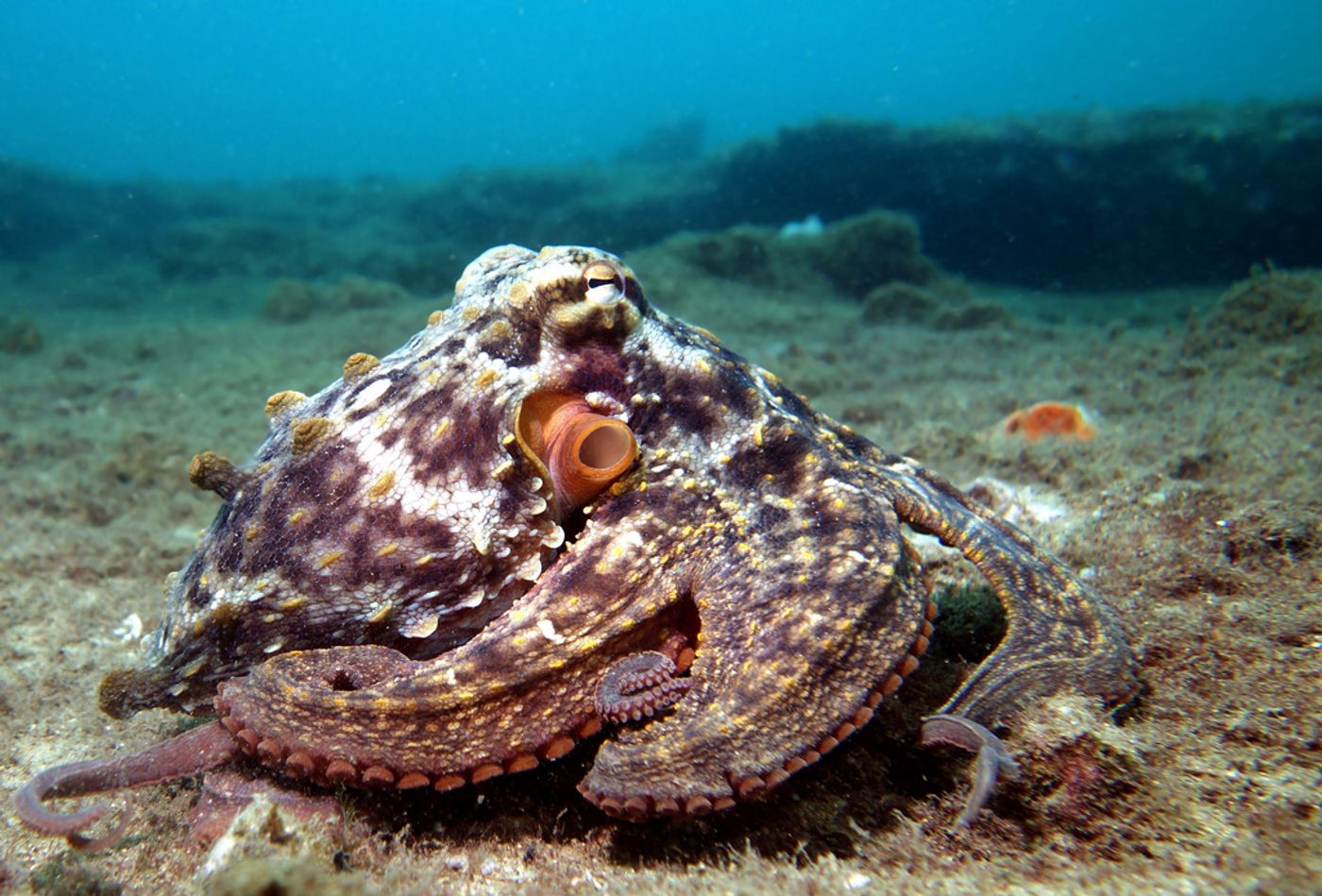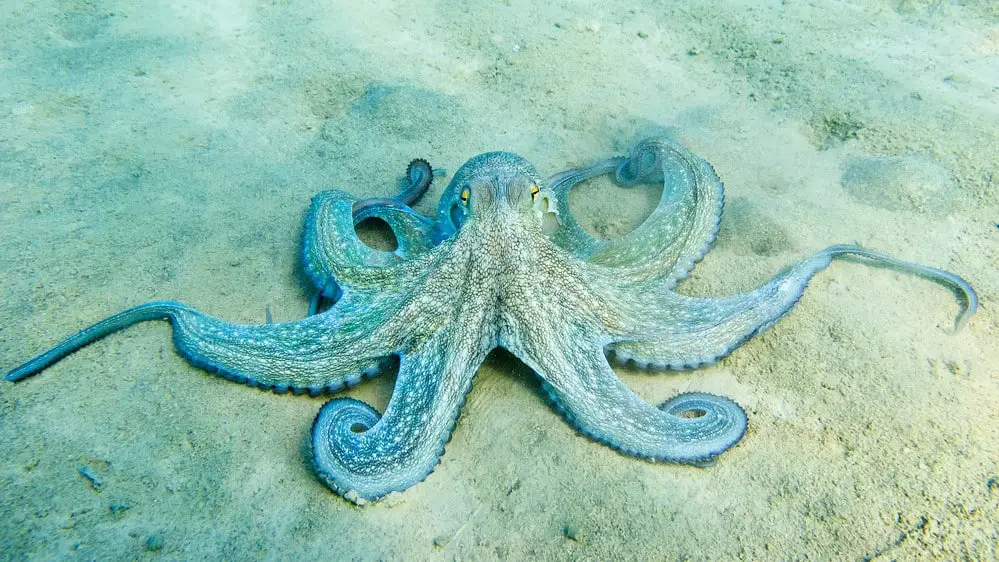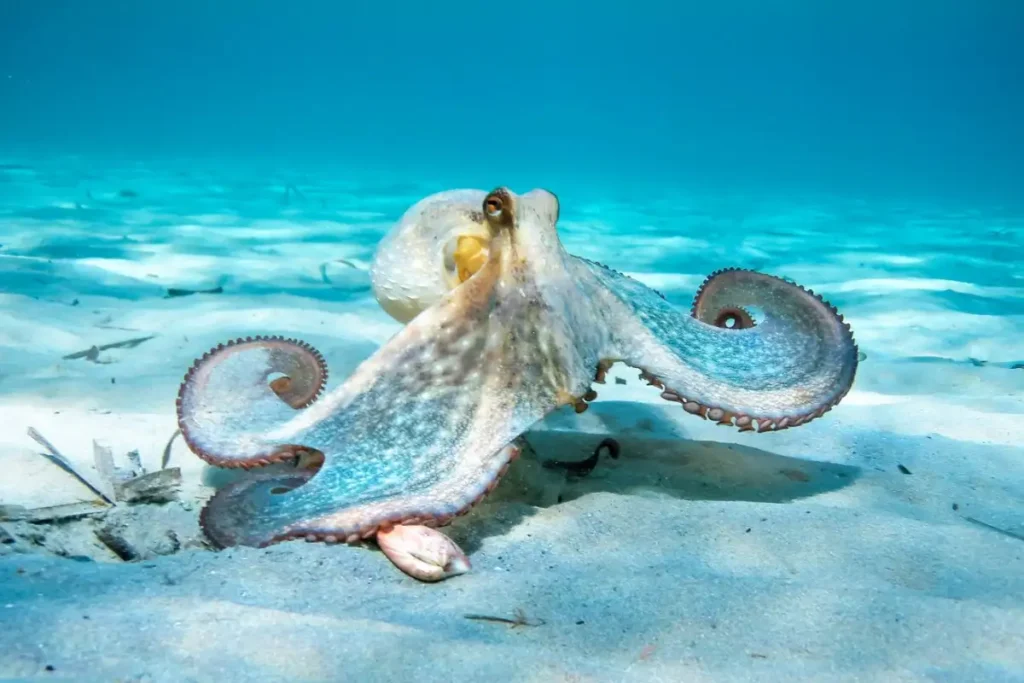How Do Octopus Change Color

Introduction
How Do Octopus Change Color: Octopuses, fascinating creatures of the deep, possess an extraordinary ability to change color and texture in an instant. This remarkable capability, often referred to as chromatophore-mediated camouflage, is a biological marvel that has puzzled scientists and captivated our imagination for centuries.
These intelligent cephalopods employ a complex system of specialized pigment-filled cells called chromatophores to achieve their mesmerizing transformations. These cells, located just beneath the octopus’s skin, are connected to an intricate network of nerves and starfish muscles. By contracting or relaxing these muscles, the octopus can expand or contract the chromatophores, which in turn alters the color and pattern of its skin.
The primary purpose of this color-changing ability is camouflage, allowing octopuses to seamlessly blend into their surroundings and avoid predators. But it’s not just about hiding; octopuses also use their color-changing skills for communication, signaling their intentions to other members of their species or conveying their mood and emotions.
Understanding the mechanisms behind octopus color change is not only a testament to the wonders of nature but also holds significant scientific potential. Studying these creatures could inspire breakthroughs in the fields of materials science and technology, leading to innovations in adaptive camouflage and flexible display technologies.

Do octopuses change color consciously?
A conscious octopus changes its color and patterning on a dime to fool prey or escape danger. According to Jennifer Mather, a psychologist at the University of Lethbridge in Alberta, Canada, the color changes originate from a spontaneous, unconscious firing in the octopus’s optic lobe.
While it’s clear that octopuses can change color in response to various environmental factors, such as their surroundings or the presence of predators, the extent to which they do so consciously is not entirely understood. Some researchers argue that octopuses have a degree of conscious control over their color changes, allowing them to adapt to different situations intentionally. This would suggest a level of awareness and decision-making on the octopus’s part.
However, others propose that color changes in octopuses may primarily be a reflexive or automatic response to stimuli, similar to how our own pupils constrict in response to bright light without conscious thought. In this view, octopuses may not be consciously choosing their colors but rather reacting instinctively to their environment.
Further research is needed to definitively answer this question and gain a deeper understanding of the cognitive processes at play in octopus behavior. Studying these incredible animals continues to unveil the mysteries of their intelligence and abilities, leaving us in awe of the complex and enigmatic world of cephalopods.
How fast can an octopus change color?
200 milliseconds
No creature on the planet can change its camouflage as fast and effectively as an octopus, cuttlefish or squid. These speed merchants of adaptive coloration can change their skin’s color, brightness, contrast and pattern in as little as 200 milliseconds — one-fifth of one second — as fast as a human eyeblink.
Octopuses are masters of rapid color change, showcasing their astonishing abilities within milliseconds. Their capacity to change color with exceptional speed is a product of their intricate and highly specialized skin. The primary mechanism behind this phenomenon is the chromatophore, a pigment-filled cell embedded in the octopus’s skin.
Each chromatophore is equipped with an elastic sac containing pigment granules, surrounded by radial muscles. When an octopus wants to change color, it contracts or relaxes these muscles, thereby altering the size and shape of the sac. This manipulation of the sac’s structure enables the octopus to change the color and pattern of the skin by expanding or contracting specific chromatophores.
The speed at which this process occurs is truly remarkable. In just a fraction of a second, octopuses can transition from one color to another, blend seamlessly into their surroundings, or display intricate patterns for communication or intimidation. Their rapid color change abilities are critical for survival, allowing them to evade predators, stalk prey, or engage in complex social interactions.
This astonishing feat of nature’s engineering serves as a constant source of fascination for scientists and nature enthusiasts alike, illustrating the immense complexity and adaptability of these enigmatic creatures in the underwater world.
How do octopus know how to camouflage if they do not see in color?
Many of these creatures have special pigment cells called chromatophores in their skin. By controlling the size of the cells they can vary their color and even create changing patterns. Chromatophores are connected to the nervous system, and their size is determined by muscular contractions.
While it’s true that octopuses are colorblind, they possess an array of sensory adaptations and strategies that allow them to master the art of camouflage.
- Texture and Pattern Matching: Octopuses have an acute ability to perceive and mimic the texture and pattern of their surroundings. They use specialized cells in their skin called papillae to create bumps, ridges, and textures that closely resemble the surfaces they’re on, whether it’s rocky terrain or sandy seabeds.
- Light Detection: Although they lack color vision, octopuses are sensitive to changes in light and shadow. They can detect variations in light intensity and adjust their color and pattern accordingly to blend in seamlessly with their environment.
- Chemoreception: Octopuses possess an extraordinary sense of taste and smell. By tasting the water around them and detecting chemical cues from their surroundings, they can anticipate the presence of potential threats or prey, allowing them to adjust their camouflage as needed.
- Innate Behavior: Some aspects of octopus camouflage may be instinctual or hardwired into their behavior. They may have a repertoire of pre-programmed camouflage patterns and colors for different situations, which they can deploy without the need for visual feedback.
In essence, octopuses rely on a combination of sensory information, including touch, light sensitivity, chemical cues, and instinctual behaviors, to achieve their remarkable camouflage abilities. Their ability to adapt to diverse environments and deceive both predators and prey serves as a testament to the incredible adaptability and resourcefulness of these remarkable cephalopods.
Do octopus change color on purpose?
The most obvious reason such a soft-bodied animal would change color is to hide from predators—and octopuses are very good at this. They can change not only their coloring, but also the texture of their skin to match rocks, corals and other items nearby.
Octopuses are known for their incredible color-changing abilities, but the question of whether they change color on purpose is a complex one. Octopuses are highly intelligent and exhibit sophisticated behaviors, including the use of their color-changing abilities for various purposes. While octopuses may not possess consciousness in the same way humans do, they do exhibit intentionality in their color changes. Here are some key aspects to consider:
- Adaptive Responses: Octopuses change color as an adaptive response to their environment. They actively use their chromatophores and other pigment cells to blend into their surroundings, which suggests a level of intentionality.
- Communication: Octopuses often change color as a form of communication. They use color displays to convey their mood, intentions, and even to signal aggression or submission to other octopuses. This implies a purposeful use of color changes to convey specific messages.
- Hunting and Predation: When hunting, octopuses may use color changes strategically to approach prey stealthily or to startle and capture it. Again, this demonstrates a deliberate use of their color-changing abilities.
- Camouflage: Octopuses employ camouflage not only for concealment but also to avoid predators intentionally. They actively assess threats and adjust their coloration accordingly.
What are 5 interesting facts about octopus?
10 Astounding Facts About Octopuses
- Octopus arms have a mind of their own.
- They have (literally) a lot of heart.
- Males die after mating, too.
- They’re masters of camouflage.
- Females give their lives to protect their eggs.
- They’re smart enough to use tools.
- They sometimes build underwater cities.
Octopuses are among the most intriguing and enigmatic creatures of the ocean. Here are five interesting facts about them:
- Masters of Camouflage: Octopuses are renowned for their unparalleled camouflage abilities. They can change the color and texture of their skin almost instantly, allowing them to blend seamlessly into their surroundings. This remarkable skill helps them evade predators and stalk prey effectively.
- Elastic Bodies and No Bones: Unlike most animals, octopuses have no bones. Their bodies are soft and highly flexible, which enables them to squeeze through tiny crevices and openings in search of food or to escape from predators. This flexibility is a key aspect of their adaptability.
- Intelligence and Problem-Solving: Octopuses are incredibly intelligent. They have been known to solve complex puzzles, open jars to access food, and even demonstrate learning capabilities. Their problem-solving abilities have captivated researchers and highlight their advanced cognitive skills.
- Multiple Hearts and Blood Blue: Octopuses have three hearts. Two pump blood to the gills, while the third circulates it to the rest of the body. Their blood is blue because it contains a copper-based molecule called hemocyanin, which is more efficient for oxygen transport in cold, low-oxygen environments.
- Short Lifespan and Semelparity: Most octopus species have relatively short lifespans, often just a few years. Additionally, many octopuses are semelparous, meaning they reproduce only once in their lifetime. After mating, the female lays thousands of eggs and dedicates herself to guarding and caring for them until they hatch, typically dying shortly afterward.
These facts showcase the extraordinary adaptability, intelligence, and unique biology of octopuses, making them some of the most captivating and mysterious creatures in the animal kingdom.
Can octopuses change color to match any background?
Octopuses are masters of disguise, renowned for their ability to change color and texture to blend seamlessly with their surroundings. This remarkable feat is made possible by specialized cells called chromatophores in their skin. Each chromatophore contains a sac of pigment and is surrounded by muscles. When the octopus wants to change color, it contracts or expands these muscles, thereby altering the size and shape of the chromatophores.
Additionally, octopuses possess other cells known as iridophores and leucophores, which contribute to their astonishing camouflage abilities. Iridophores reflect light in a way that can produce shimmering blues and greens, while leucophores reflect light in a diffused manner, creating a silvery appearance.
This color-changing ability serves a crucial purpose in the octopus’s survival strategy. It allows them to evade predators by blending into their environment, or to ambush prey by disguising themselves as part of the scenery. This skill is further refined by the octopus’s exceptional intelligence and problem-solving capabilities.
In essence, octopuses are the artists of adaptation, using their unique biology to transform their appearance, making them one of the most intriguing and visually captivating creatures in the underwater world. Their remarkable color-changing abilities continue to be a subject of fascination and study for scientists and nature enthusiasts alike.
Can other cephalopods, like squids and cuttlefish, change color in a similar way?
Other cephalopods, such as squids and cuttlefish, share a similar ability to change color, albeit with some variations in the mechanisms involved. Like octopuses, squids and cuttlefish also possess specialized cells called chromatophores, which contain pigments and are controlled by muscles. When these muscles contract or expand, the chromatophores change shape, altering the color and pattern of the cephalopod’s skin.
In addition to chromatophores, squids and cuttlefish have other unique features. For instance, they have a special layer of cells called iridophores, which create iridescent effects. These cells reflect and refract light, producing a shimmering appearance.
Cuttlefish, in particular, are renowned for their exceptional ability to rapidly change both color and texture, often using this skill in intricate displays during courtship and communication. The color-changing abilities of these cephalopods serve a range of purposes, including camouflage, communication, and hunting strategies.
While octopuses, squids, and cuttlefish share the capacity to change color, each species possesses its own unique adaptations and nuances in this remarkable biological feature, further showcasing the fascinating diversity within the cephalopod family.
How quickly can octopuses change color?
Octopuses are astonishingly quick-change artists, capable of altering their coloration in a matter of milliseconds. This incredible speed is due to the highly specialized cells in their skin called chromatophores. Each chromatophore is controlled by surrounding muscles. When these muscles contract, the chromatophore expands, revealing its pigment, and when they relax, it contracts and disappears.
This rapid color change serves a variety of purposes. In the blink of an eye, an octopus can transition from being nearly invisible against a background to displaying bold and contrasting patterns. This skill is invaluable for survival, allowing them to evade predators, stalk prey, and communicate with other octopuses.
The speed at which octopuses change color is a testament to their impressive nervous system and sensory capabilities. They process visual information incredibly quickly, enabling them to react to their environment with astonishing agility. Additionally, octopuses are known for their high intelligence, and their ability to rapidly adapt their appearance is just one of the many remarkable traits that make them such fascinating creatures in the world of marine biology.

Conclusion
The remarkable ability of octopuses to change color stands as a testament to the incredible diversity and adaptability of life in the oceans. Through the intricate coordination of chromatophores, muscles, nerves, and hormones, these cephalopods can transform their appearance in a matter of seconds, a feat that has long captivated scientists and enthusiasts alike.
Octopuses employ this skill primarily for survival, using it as a powerful tool for camouflage to avoid predators or ambush prey. However, their color-changing abilities extend beyond mere survival tactics. Octopuses also use color and pattern changes for communication, expressing complex messages and emotions without the need for vocalization.
The study of octopus color change not only deepens our understanding of marine life but also holds promise for various applications. Researchers have looked to nature’s world for inspiration in developing adaptive camouflage technologies, which could have profound implications in fields such as military stealth, marine conservation, and even fashion.
As we continue to unlock the mysteries of these enigmatic creatures, we gain not only a greater appreciation for the wonders of the natural world but also valuable insights that may shape the future of science and technology. Octopuses, with their ever-changing hues, serve as a reminder that beneath the surface of our oceans lies a world of awe-inspiring complexity and beauty yet to be fully explored.



